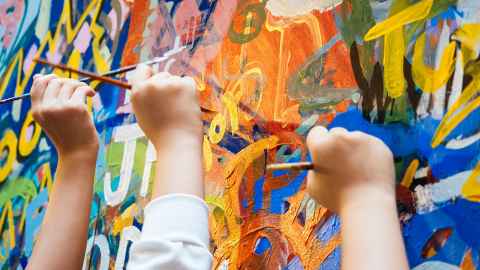Why not resource all teachers to be creatives?
20 June 2019
Opinion: Why is the Government putting 'creatives' in schools rather than resourcing all teachers to be creative, asks Peter O'Connor.

Why do I feel a little sick in my stomach, rather than excited, about the newly announced government initiative, Creatives in Schools? The word creative is an adjective, it describes a process where novel, beautiful and wondrous things are made.
Creatives in Schools uses creative as a noun, and as such, creates a false, and I believe unhelpful, binary that suggests there are creatives and non-creatives. The reality is that we are all inherently creative and it’s important that teachers see themselves that way, with or without a visiting ‘creative’ in their classroom.
Schools as we know them were originally designed at the same time as mass industrialisation began. Not surprisingly, factories and schools centre around the testing and standardisation of the products they make and value conformity and uniformity.
Creativity in these environments shrivels because its fundamentals include a willingness to take risks, to be curious, to be playful with ideas and to consider possibilities to make something not seen or imagined before.
This approach has never been a feature of New Zealand schools, except in isolated instances and for a brief period in the 1950s, when progressive education philosophies were introduced.
Unless there is significant investment in reinstating and resourcing the arts curriculum, creativity will remain a rare sight in New Zealand schools.
The vitality of schools at the time was based on the twin ideas that the arts train the imagination, and the social imagination is vital for social progress, social justice and national wellbeing. There was a strong belief that the arts and education were foundation stones for a strong democracy.
It was understood that one of school’s primary functions was to create critical, creative, empathetic citizens as a safeguard against the rise of extremism. The arts have struggled ever since to gain traction in a system that has valued particular forms of knowledge over others. And although the arts are a major industry, contributing billions to the New Zealand economy, they aren’t seen as valid as so-called ‘hard disciplines’.
I believe nine years of National Standards essentially killed off creativity in New Zealand schools. The overriding focus on science, technology, engineering and maths (STEM) was highly effective in dismantling the arts across the whole education system, including schools and the tertiary sector.
The provision of training in the arts in Initial Teacher Education in New Zealand is appallingly inadequate. Teachers trained in the last ten years, who then had to implement National Standards in primary schools, have little or no understanding of how to be creative teachers or how to teach or use the arts in their classrooms.
Music, dance and drama have particularly suffered. Teachers have been starved of professional development in the arts, alongside so many other discipline areas. Teachers need opportunities to engage in this field and to understand the potential for cross-curricular learning to skilfully build the arts into their everyday teaching.
The Ministry of Education hasn’t developed any new resource material to support the teaching of the arts in more than 15 years, so there is very little available that is recent, relevant and geared to the New Zealand context or curriculum.
In the announcement of the Creatives in Schools scheme, there is no mention of the arts curriculum. Instead it ties the outcomes of the project to the same old generic and self-limiting competencies belonging to every subject.
It’s almost as if the Ministry has forgotten we still have the arts in the National Curriculum. The arts curriculum is the vital tool for teachers to be creative with their children and to be creative themselves.
The initiative also exists outside any wider context or strategy for the arts across government. At a minimum, the initiative needs to be part of a wider policy direction on the arts and young people. There remains an opportunity to develop a national arts strategy that considers how the arts feed into all areas of government policy.
If the project was pitched to support that curriculum rather than support artists into work, I might not feel so uneasy. However, unless there is significant investment in reinstating and resourcing the arts curriculum, creativity will remain a rare sight in New Zealand schools.
A national strategy should centre on the vital role the arts play in protecting democracy and averting the appeal of radical and dehumanising ideologies. That is a genuine wellbeing goal. The arts in education would then be of central importance in this wider strategy, and Creatives in Schools might begin to make sense and make a difference.
Peter O'Connor is an expert in applied theatre and a professor in the Faculty of Education and Social Work.
This article reflects the opinion of the author and not necessarily the views of the University of Auckland.
Used with permission from Education Central Why are we not resourcing all teachers to be creatives? published on 19 June 2019.